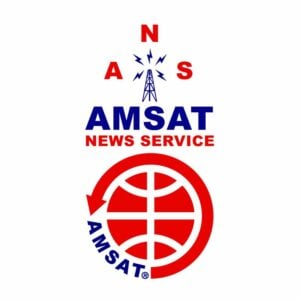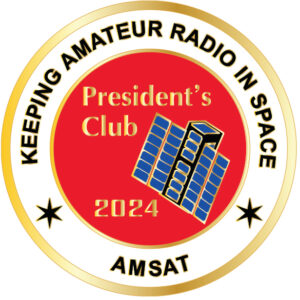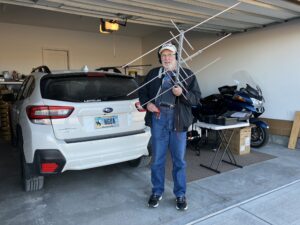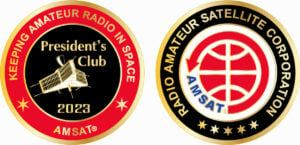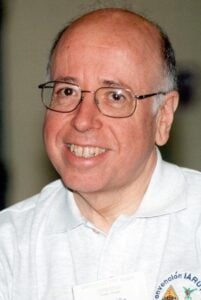In this edition:
* ARISS Announces NASA Astronaut Tony England WØORE as Speaker for 40th Anniversary Celebration
* AMSAT Seeks Volunteers to Assist with AMSAT Booth at 2024 HamCation in Orlando Florida
* Vulcan Centaur Triumphs in Maiden Voyage, Peregrine Lander Faces Lunar Setback
* GridMasterMap Satellite Top 100 Rovers January 2024 Rankings
* Changes to AMSAT-NA TLE Distribution for January 12, 2024
* ARISS News
* Upcoming Satellite Operations
* Hamfests, Conventions, Maker Faires, and Other Events
* Satellite Shorts from All Over
The AMSAT News Service bulletins are a free, weekly news and information service of AMSAT, the Radio Amateur Satellite Corporation. ANS publishes news related to Amateur Radio in Space including reports on the activities of a worldwide group of Amateur Radio operators who share an active interest in designing, building, launching and communicating through analog and digital Amateur Radio satellites.
The news feed on https://www.amsat.org publishes news of Amateur Radio in Space as soon as our volunteers can post it.
Please send any amateur satellite news or reports to: ans-editor [at] amsat.org
You can sign up for free e-mail delivery of the AMSAT News Service Bulletins via the ANS List; to join this list see: https://mailman.amsat.org/postorius/lists/ans.amsat.org
ANS-014 AMSAT News Service Weekly Bulletins
To: All RADIO AMATEURS
From: Radio Amateur Satellite Corporation
712 H Street NE, Suite 1653
Washington, DC 20002
DATE 2024 Jan 14
ARISS Announces NASA Astronaut Tony England WØORE as Speaker for 40th Anniversary Celebration
Amateur Radio on the International Space Station (ARISS) has announced NASA astronaut Tony England WØORE as the latest addition to the esteemed lineup for the “40th Anniversary Conference: Celebrating the Positive Impact of Amateur Radio on Human Spaceflight” event at Kennedy Space Center, set to occur from February 22 to 24, 2024. Tony England will be the third astronaut speaker at the event, in addition to Richard Garriott, W5KQW, and Bill McArthur, KC5ACR.
Tony England, the second astronaut to make ham radio contacts from space and the first to engage in Slow-Scan Television (SSTV) transmissions from orbit, brings a wealth of experience to the event. Selected as a scientist-astronaut by NASA in August 1967 at the age of 25, he holds the distinction of being the youngest candidate selected up to that time. England completed rigorous academic and flight training, earning his wings with distinguished honors in April 1969.
His contributions to space missions include serving as a support crewman for Apollo 13 and 16 flights. Notably, England played a crucial role during the Apollo 16 mission as the Extra-Vehicular Activity (EVA) Capcom, providing instructions to astronauts exploring the lunar surface. His expertise also extended to the development and communication of instructions for constructing lithium hydroxide canisters on Apollo 13.
In the summer of 1985, England was a part of the STS-51-F mission, which carried a seven-man crew and Spacelab-2. This mission marked the first pallet-only Spacelab mission and the debut of the Spacelab Instrument Pointing System (IPS). England’s responsibilities included activating and operating Spacelab systems, operating the IPS and the Remote Manipulator System, assisting with experiment operations, and being prepared for a contingency Extra-Vehicular Activity if needed. The mission successfully completed 126 orbits of the Earth.
Richard Garriott W5KQW, a second-generation space traveler, ARISS veteran, and entrepreneur, has been announced as the keynote conference speaker. The 40th Anniversary Celebration event will also feature other distinguished speakers, including Bill McArthur, KC5ACR, a NASA Astronaut with experience on the Shuttle, Mir, and the International Space Station (ISS), and Mike Kincaid, NASA Associate Administrator for the Office of STEM (Science, Technology, Engineering, and Mathematics) Engagement.
The 40th Anniversary Conference is scheduled to occur at the Center for Space Education, located next to the NASA Kennedy Space Center Visitor’s Center in Florida. This event is not only a reflection on past achievements but also a platform to showcase the exciting potential of amateur radio in future human spaceflight endeavors. The discussions will encompass potential operations on commercial space stations, lunar exploration, and even ventures toward Mars. The celebration is poised to offer a retrospective of notable achievements and delve into the evolving role of amateur radio in shaping the trajectory of human space exploration. More details can be found on the ARISS website at https://www.ariss.org/overview.html.
[ANS thanks Amateur Radio on the International Space Station for the above information]
AMSAT Seeks Volunteers to Assist with AMSAT Booth at 2024 HamCation in Orlando Florida
As the new year unfolds, the spotlight shifts to HamCation 2024, scheduled for February 9th to 11th in Orlando, Florida. Celebrating its 78th year since its establishment in 1946, HamCation proudly holds the distinction of being the second-largest annual gathering of ham operators globally.
Hosted at the Central Florida Fairgrounds and Expo Park, the 87-acre lakefront fairground transforms into a bustling center for radio-centric activities during HamCation. This cornerstone event in the amateur radio community is sponsored by the Orlando Amateur Radio Club and supported by volunteers from radio clubs across the region. For a detailed itinerary and logistical information about the 2024 HamCation, interested individuals are encouraged to visit the official website at https://www.hamcation.org.
One of the standout features of HamCation is the rich variety of attractions it offers. Participants have the opportunity to navigate through a vast tailgate area, browse exhibits presented by well-known amateur radio vendors, participate in informative forums, and establish connections with individuals who share similar interests. Beyond merely showcasing equipment, the event places a strong emphasis on fostering connections, exchanging knowledge, and celebrating the collective passion for radio communication.
AMSAT extends a warm invitation to all attendees to visit their booth, where the fascinating world of amateur radio satellites can be discovered. With last year’s attendance reaching an impressive 21,800 participants, AMSAT is actively seeking volunteers from their membership to dedicate at least two to four hours of their time during the three-day event. Volunteer tasks include introducing fellow hams to the world of amateur radio satellites, assisting those facing challenges in getting on the air, and best of all, connecting face to face with hams that you have talked to on the satellites.
Robert Bankston, KE4AL, President of AMSAT, will be presenting information on Saturday, February 10th at 1:00 PM EST. His presentation, titled “AMSAT – Shaping the Amateur Radio Satellite World of Tomorrow,” will involve an open discussion on designing the next generation of amateur radio satellites. The HamCation Forums and Speakers Guide are continually being updated with the latest information and can be viewed online at https://www.hamcation.com/forums-speakers.
For those eager to be part of AMSAT’s presence at HamCation or request more information about volunteering, David Jordan, AA4KN, serves as the point of contact. Interested individuals can drop him an email at aa4kn [at] amsat.org to express their interest or seek clarification on any questions they may have. Your involvement goes beyond contributing to the event; it’s an opportunity to contribute to the vibrant community spirit that defines amateur radio.
[ANS thanks Dave Jordan, AA4KN for the above information]
The 2024 AMSAT President’s Club coins are here now!
Help Support GOLF and Fox Plus
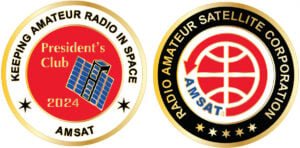
Join the AMSAT President’s Club today and help
Keep Amateur Radio in Space!
https://www.amsat.org/join-the-amsat-presidents-club/
Vulcan Centaur Triumphs in Maiden Voyage, Peregrine Lander Faces Lunar Setback
Vulcan Centaur, a new heavy-lift booster developed by United Launch Alliance (ULA), successfully completed its inaugural flight. However, the mission took a bittersweet turn as the Peregrine lander, set to be the first American spacecraft to touch down on the lunar surface since 1972, faced significant challenges shortly after separation from the Centaur upper stage.
United Launch Alliance (ULA), known for its 100% mission success rate with the Atlas V and Delta IV rockets since 2006, faced a changing commercial launch landscape by the early 2010s. SpaceX’s Falcon 9 was offering cheaper alternatives, prompting ULA to develop a more cost-effective and agile solution. The result was the Vulcan Centaur, a combination of a new first stage and an evolved Centaur III second stage.
Originally planned for launch in 2019, the Vulcan program encountered delays, primarily due to the slower-than-expected development of the BE-4 engines by Blue Origin. Despite setbacks and an explosion during Centaur upper stage testing in March 2023, the January 8th launch marked a significant achievement for ULA. Powered by liquid methane and liquid oxygen (methalox), the Vulcan Centaur demonstrated successful flight, a milestone for American orbital rockets using this propellant combination.
ULA’s CEO Tory Bruno expressed satisfaction with the launch, labeling it one of the smoothest in his career. The successful flight positions ULA to compete more effectively in the evolving space launch market.
While the Vulcan Centaur celebrated success, the fate of the Peregrine lander took a dramatic turn. Developed by Astrobotic Technology, Peregrine had ambitious plans, including bringing memorials, time capsules, scientific instruments, the Iris rover, and small robots to the lunar surface.
Initial reports suggested a promising start when Peregrine separated from the Centaur and established communications with ground control. However, soon after enabling its propulsion systems, the lander faced difficulties maintaining its orientation, leading to a rapid depletion of its batteries. Astrobotic attempted to stabilize the craft, but it was confirmed that a leak was destabilizing Peregrine and draining essential propellants needed for a lunar landing.
Astrobotic ruled out any possibility of a lunar landing, and as of the latest update, the team faces the challenge of navigating Peregrine as close to the Moon as possible before its propellant runs out. With communication uncertain, the fate of the lander remains uncertain.
January 8th showcased both success and setbacks in space exploration. The Vulcan Centaur’s triumphant launch demonstrated progress in rocket technology, while the Peregrine’s struggles highlighted the inherent difficulties of space missions. As technology advances, the moon remains an enticing destination, with the upcoming Nova-C lander’s launch in February offering renewed hope for successful lunar exploration. The events of this day remind us that despite the challenges, the pursuit of space exploration continues unabated.
[ANS thanks Tom Nardi, Hackaday.com, for the above information]
GridMasterMap Satellite Top 100 Rovers January 2024 Rankings
The January 2024 rankings for the Top 100 Rovers (Mixed LEO/MEO/GEO) in satellite operations, as determined by @GridMasterMap on Twitter, has been released. The ranking is determined by the number of grids and DXCC entities activated, taking into account only those grids where a minimum number of QSOs logged on the GridMasterMap website have been validated by a third party. Grid numbers do not directly reflect the exact number of activations. Satellite operators are encouraged to upload their LoTW satellite contacts to https://gridmaster.fr in order to provide more accurate data.
Updated: 2024-01-01
| 1 | ND9M | 26 | K8BL | 51 | F4DXV | 76 | DF2ET |
| 2 | NJ7H | 27 | KE4AL | 52 | KE9AJ | 77 | WA9JBQ |
| 3 | N5UC | 28 | LU5ILA | 53 | JL3RNZ | 78 | W8LR |
| 4 | JA9KRO | 29 | DL2GRC | 54 | KM4LAO | 79 | OE3SEU |
| 5 | DL6AP | 30 | KI7UNJ | 55 | VE1CWJ | 80 | VE3GOP |
| 6 | WI7P | 31 | VE3HLS | 56 | PA3GAN | 81 | KJ7NDY |
| 7 | UT1FG | 32 | KB5FHK | 57 | VK5DG | 82 | KB2YSI |
| 8 | HA3FOK | 33 | LA9XGA | 58 | N4UFO | 83 | K0FFY |
| 9 | N9IP | 34 | N7AGF | 59 | KI7QEK | 84 | CU2ZG |
| 10 | N6UA | 35 | F4BKV | 60 | SM3NRY | 85 | N0TEL |
| 11 | WY7AA | 36 | XE3DX | 61 | N8RO | 86 | DL4EA |
| 12 | K5ZM | 37 | N6DNM | 62 | PT2AP | 87 | W8MTB |
| 13 | AD0DX | 38 | KE0PBR | 63 | W1AW | 88 | KG4AKV |
| 14 | W5PFG | 39 | KE0WPA | 64 | VA7LM | 89 | VE6WK |
| 15 | DP0POL | 40 | JO2ASQ | 65 | XE1ET | 90 | VE7PTN |
| 16 | AK8CW | 41 | PR8KW | 66 | AA8CH | 91 | HB9GWJ |
| 17 | AD0HJ | 42 | AC0RA | 67 | M1DDD | 92 | AF5CC |
| 18 | WD9EWK | 43 | K7TAB | 68 | VA3VGR | 93 | DK9JC |
| 19 | ON4AUC | 44 | W7WGC | 69 | VE1VOX | 94 | PT9ST |
| 20 | KG5CCI | 45 | EB1AO | 70 | FG8OJ | 95 | JM1CAX |
| 21 | KX9X | 46 | JK2XXK | 71 | PT9BM | 96 | KI0KB |
| 22 | ND0C | 47 | EA4NF | 72 | KI7UXT | 97 | VO2AC |
| 23 | N5BO | 48 | AA5PK | 73 | LU4JVE | 98 | LW2DAF |
| 24 | F5VMJ | 49 | SP5XSD | 74 | YU0W | 99 | N4AKV |
| 25 | DJ8MS | 50 | AD7DB | 75 | N4DCW | 100 | N6UTC |
[ANS thanks @GridMasterMap for the above information]
Need new satellite antennas? Purchase Arrows, Alaskan Arrows,
and M2 LEO-Packs from the AMSAT Store. When you purchase through
AMSAT, a portion of the proceeds goes towards

Keeping Amateur Radio in Space.
https://amsat.org/product-category/hardware
Changes to AMSAT-NA TLE Distribution for January 12, 2024
Two Line Elements or TLEs, often referred to as Keplerian elements or keps in the amateur community, are the inputs to the SGP4 standard mathematical model of spacecraft orbits used by most amateur tracking programs. Weekly updates are completely adequate for most amateur satellites. TLE bulletin files are updated daily in the first hour of the UTC day. New bulletin files will be posted immediately after reliable elements become available for new amateur satellites. More information may be found at https://www.amsat.org/keplerian-elements-resources/.
DELFI-PQ NORAD Cat ID 51074 Decayed from orbit on or about 06 January 2024
Pegasus NORAD Cat ID 42784 Decayed from orbit on or about 07 January 2024
[ANS thanks AMSAT Orbital Elements page for the above information]
ARISS News
Amateurs and others around the world may listen in on contacts between amateurs operating in schools and allowing students to interact with astronauts and cosmonauts aboard the International Space Station. The downlink frequency on which to listen is 145.800 MHz worldwide.
No contacts have been scheduled from 2023-12-21 to 2024-01-14. The complete schedule page has been updated as of 2023-12-21 05:00 UTC.
The crossband repeater continues to be active (145.990 MHz up {PL 67} & 437.800 MHz down), If any crewmember is so inclined, all they have to do is pick up the microphone, raise the volume up, and talk on the crossband repeater. So give a listen, you just never know.
The Service Module radio is temporarily stowed. Targeting return to service once a new computer has been delivered for SSTV use with this system.
As always, if there is an EVA, a docking, or an undocking; the ARISS radios are turned off as part of the safety protocol.
The latest information on the operation mode can be found at https://www.ariss.org/current-status-of-iss-stations.html
The latest list of frequencies in use can be found at https://www.ariss.org/contact-the-iss.html
[ANS thanks Charlie Sufana, AJ9N, one of the ARISS operation team mentors for the above information]
Upcoming Satellite Operations
No scheduled operations are listed at this time.
A growing number of satellite rovers are currently engaged in sharing their grid square activations on https://hams.at. By visiting the website, you gain easy access to comprehensive information about the operators responsible for activating specific grid squares. Additionally, you have the ability to assess the match score between yourself and a particular rover for a given pass, while also being able to identify the upcoming satellite passes that are accessible from your location.
[ANS thanks Ian Parsons, K5ZM, AMSAT Rover Page Manager, for the above information]
Hamfests, Conventions, Maker Faires, and Other Events
AMSAT Ambassadors provide presentations, demonstrate communicating through amateur satellites, and host information tables at club meetings, hamfests, conventions, maker faires, and other events.
+ Orlando HamCation 2024
Friday February 9th through Sunday February 11th, 2024
Central Florida Fairgrounds and Expo Park
4603 West Colonial Drive
Orlando, Florida 32808
https://www.hamcation.com
+ 40th Anniversary Celebration of the Positive Impact of Amateur Radio on Human Spaceflight
Thursday February 22nd through Saturday February 24th, 2024
Center for Space Education: Astronauts Memorial Foundation
Kennedy Space Center, M6-306 405 State Road, FL 32899
https://www.ariss.org/overview.html
+ Dayton Hamvention 2024
Friday May 17th through Sunday May 19th, 2024
Greene County Fairgrounds and Expo Center
120 Fairground Road
Xenia, OH 45385
https://hamvention.org
[ANS thanks the AMSAT Events page for the above information]
Want to fly the colors on your own grid expedition?
Get your AMSAT car flag and other neat stuff
from our Zazzle store!
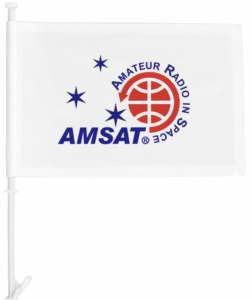
25% of the purchase price of each product goes
towards Keeping Amateur Radio in Space
https://www.zazzle.com/amsat_gear
Satellite Shorts from All Over
+ Liftoff of Axiom Mission 3 (Ax-3) is scheduled for 22:11 UTC Wednesday, Jan. 17, from Launch Complex 39A at NASA’s Kennedy Space Center in Florida. The crew will travel to the orbiting outpost aboard the SpaceX Dragon spacecraft after launching on the company’s Falcon 9 rocket. The Ax-3 crew members are Commander Michael López-Alegría, KE5GTK, Pilot Walter Villadei, IU0RWB, of Italy, Mission Specialist Alper Gezeravcı, KJ5DIY, of Turkey, and ESA (European Space Agency) project astronaut Marcus Wandt, KJ5COO, of Sweden. Watch live coverage of prelaunch and launch activities, as well as docking operations on the NASA+ streaming service at https://plus.nasa.gov. (ANS thanks NASA for the above information.)
+ ARISS is calling for proposals from U.S. educational institutions to host an Amateur Radio contact with ISS crew members between July 1, 2024, and December 31, 2024. They seek organizations drawing large participation to integrate the contact into an education plan. Proposals are due by February 29, 2024, with details at https://www.ariss.org. A 10-minute Q&A session with astronauts provides students a firsthand experience of space life and research. Amateur Radio organizations worldwide, with support from NASA and international space agencies, facilitate these contacts. An ARISS Introductory Webinar on January 17, 2024, at 7 PM ET via Zoom is available for those interested. Inquiries can be directed to education [at] ariss-usa.org. ARISS aims to promote STEM exploration through radio contacts between ISS crew members and students. (ANS thanks Dave Jordan, AA4KN, ARISS Public Relations, for the above information)
+ India has marked another significant milestone in space exploration with the successful placement of the Aditya L-1 spacecraft into a periodic Halo orbit approximately 1.5 million kilometers from Earth. This accomplishment follows India’s pioneering achievement of landing an unmanned spacecraft on the moon’s southern polar region four months earlier. Named after the Hindu god of the sun, Aditya-L1 is strategically positioned at Lagrange Point 1, providing an uninterrupted five-year study of the sun’s outer layer. This achievement underscores India’s unique capability to travel vast distances in space, setting it apart as the first in Asia to do so. With a focus on understanding space weather, the spacecraft is equipped with seven scientific instruments to monitor solar wind particles and magnetic fields. (ANS thanks Anjana Pasricha, Voice of America, for the above information)
+ NASA has announced delays to its Artemis program, pushing back the anticipated return of astronauts to the moon to 2026. The Artemis 2 mission, originally scheduled for November 2024, is now set for September 2025, while the Artemis 3 moon-landing mission, initially targeted for late 2025, is rescheduled for September 2026. NASA Administrator Bill Nelson emphasized that safety is the top priority, allowing more time for teams to address challenges with first-time developments, operations, and integration. Jim Free, NASA’s associate administrator, underscored the decision’s focus on crew safety. Various new systems and technologies, such as facilities at Kennedy Space Center and improvements to the Orion capsule, are still being tested ahead of Artemis 2. Despite setbacks, NASA remains enthusiastic about Artemis 2, seeing it as a representation of national and global achievements in space exploration. (ANS thanks Brett Tingley, Space.com, for the above information)
+ The Japan Aerospace Exploration Agency (JAXA) has successfully inserted the Smart Lander for Investigating Moon (SLIM) into lunar orbit on December 25, 2023, at 16:51 (JST). SLIM’s elliptical lunar orbit, connecting the Moon’s north and south poles, has a 6.4-hour period, ranging from approximately 600km at perilune (closest point to the Moon) to 4,000km at apolune (furthest point). The orbit adjustment proceeded as planned, and the spacecraft is currently in normal condition. Over the next few weeks until mid-January 2024, SLIM’s apolune point will be lowered, transitioning the orbit to a circular one at around 600km altitude. Subsequently, preparations for landing will commence, with the perilune point scheduled to be lowered to 15km on January 19, initiating the descent towards the lunar surface around 00:00 AM (JST) on January 20, and landing expected at approximately 00:20 AM (JST) on the same day. (ANS thanks Japan Aerospace Exploration Agency (JAXA) for the above information)
Join AMSAT today at https://launch.amsat.org
In addition to regular membership, AMSAT offers membership to:
* Societies (a recognized group, clubs or organization).
* Primary and secondary school students are eligible for membership at one-half the standard yearly rate.
* Post-secondary school students enrolled in at least half-time status shall be eligible for the student rate for a maximum of 6 post-secondary years in this status.
* Memberships are available for annual and lifetime terms.
Contact info [at] amsat.org for additional membership information.
73 and remember to help Keep Amateur Radio in Space!
This week’s ANS Editor, Mitch Ahrenstorff, ADØHJ
ad0hj [at] amsat.org

